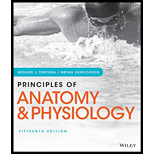
Define each of the following external features of the heart: auricle, coronary sulcus, anterior interventricular sulcus, and posterior interventricular sulcus.
To review:
The given terms of the heart: posterior interventricular sulcus, auricle, anterior interventricular sulcus, and coronary sulcus.
Introduction:
The heart is the prime organ of the circulatory system of the body. It is a four-chambered organ that pumps blood throughout the body. It lies between the two lungs and is slightly oriented towards the left side of the body. It is protected by a three-layered pericardium layer. The upper chamber of the heart, which forms the base of the heart is called auricle while the lower chambers forming the apex as ventricles.
Explanation of Solution
Auricle: It is a pouch-like structure, which is located on the anterior portion of the atria. It is slightly wrinkled and functions to increase the capacity of the atria in holding a large volume of blood.
Coronary sulcus: The heart is marked by groves externally (sulci), which contains the blood vessels and fat deposition. The coronary sulcus is present between the upper atria and the lower ventricles.
Anterior interventricular sulcus: This sulcus is present on the anterior potion of the heart between the left and right ventricles.
Posterior interventricular sulcus: This sulcus is present on the posterior surface of the heart between the left and the right ventricles. This sulcus is in continuation with the anterior interventricular sulcus.
Thus, the auricle is an extension of the atria, which increases the capacity of the heart in terms of holding blood. The sulci are the grooves present on the heart's surface, which consists of fat and blood vessels and is named as per their location on the heart.
Want to see more full solutions like this?
Chapter 20 Solutions
Principles of Anatomy and Physiology
Additional Science Textbook Solutions
Laboratory Manual For Human Anatomy & Physiology
Physical Universe
SEELEY'S ANATOMY+PHYSIOLOGY
Biology: Life on Earth with Physiology (11th Edition)
Microbiology Fundamentals: A Clinical Approach
- Noggin mutation: The mouse, one of the phenotypic consequences of Noggin mutationis mispatterning of the spinal cord, in the posterior region of the mouse embryo, suchthat in the hindlimb region the more ventral fates are lost, and the dorsal Pax3 domain isexpanded. (this experiment is not in the lectures).a. Hypothesis for why: What would be your hypothesis for why the ventral fatesare lost and dorsal fates expanded? Include in your answer the words notochord,BMP, SHH and either (or both of) surface ectoderm or lateral plate mesodermarrow_forwardNot part of a graded assignment, from a past midtermarrow_forwardNot part of a graded assignment, from a past midtermarrow_forward
- please helparrow_forwardWhat does the heavy dark line along collecting duct tell us about water reabsorption in this individual at this time? What does the heavy dark line along collecting duct tell us about ADH secretion in this individual at this time?arrow_forwardBiology grade 10 study guidearrow_forward
 Human Physiology: From Cells to Systems (MindTap ...BiologyISBN:9781285866932Author:Lauralee SherwoodPublisher:Cengage Learning
Human Physiology: From Cells to Systems (MindTap ...BiologyISBN:9781285866932Author:Lauralee SherwoodPublisher:Cengage Learning Human Biology (MindTap Course List)BiologyISBN:9781305112100Author:Cecie Starr, Beverly McMillanPublisher:Cengage Learning
Human Biology (MindTap Course List)BiologyISBN:9781305112100Author:Cecie Starr, Beverly McMillanPublisher:Cengage Learning Fundamentals of Sectional Anatomy: An Imaging App...BiologyISBN:9781133960867Author:Denise L. LazoPublisher:Cengage Learning
Fundamentals of Sectional Anatomy: An Imaging App...BiologyISBN:9781133960867Author:Denise L. LazoPublisher:Cengage Learning





